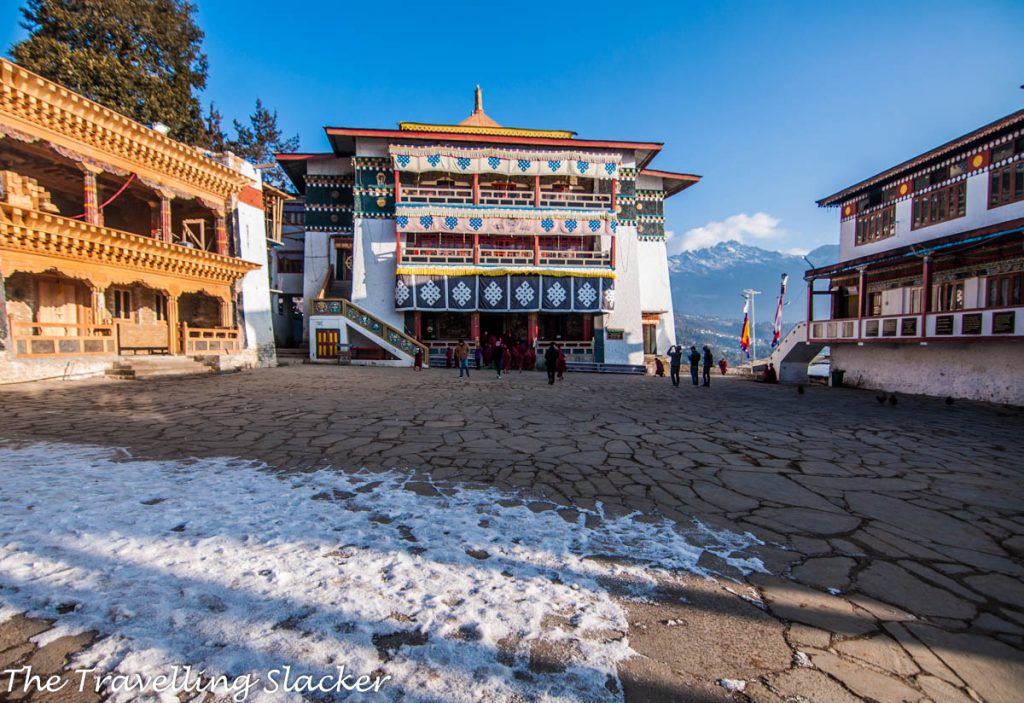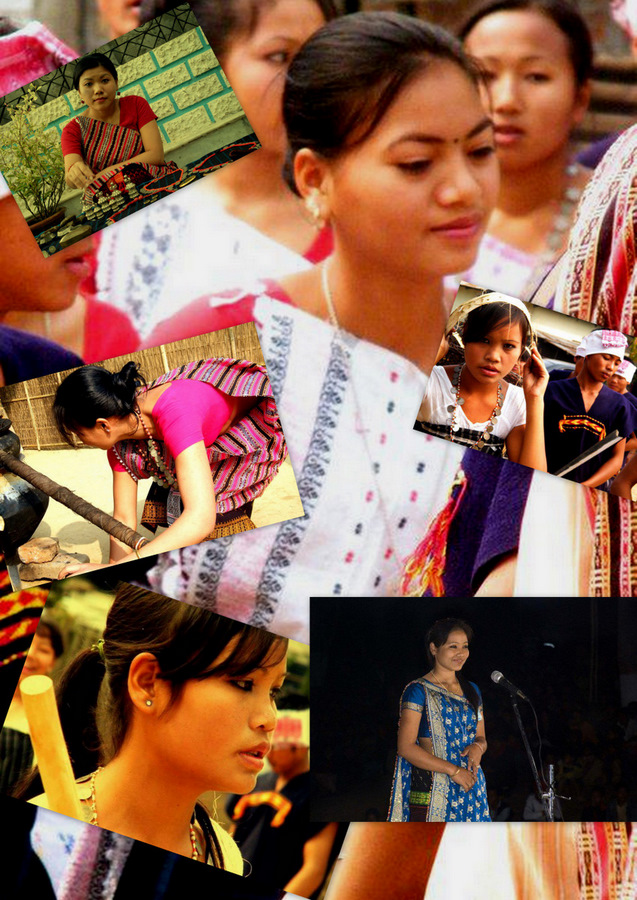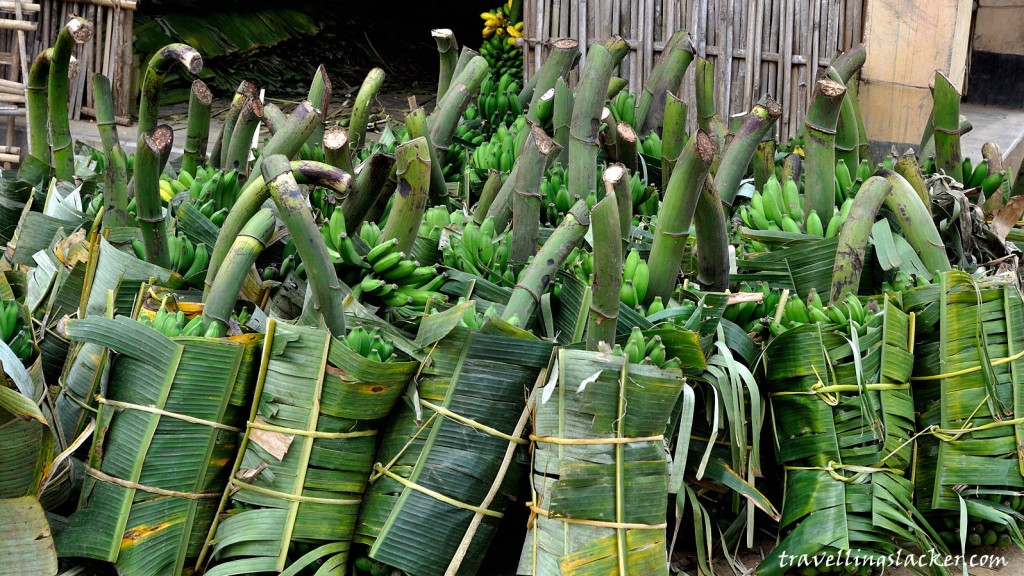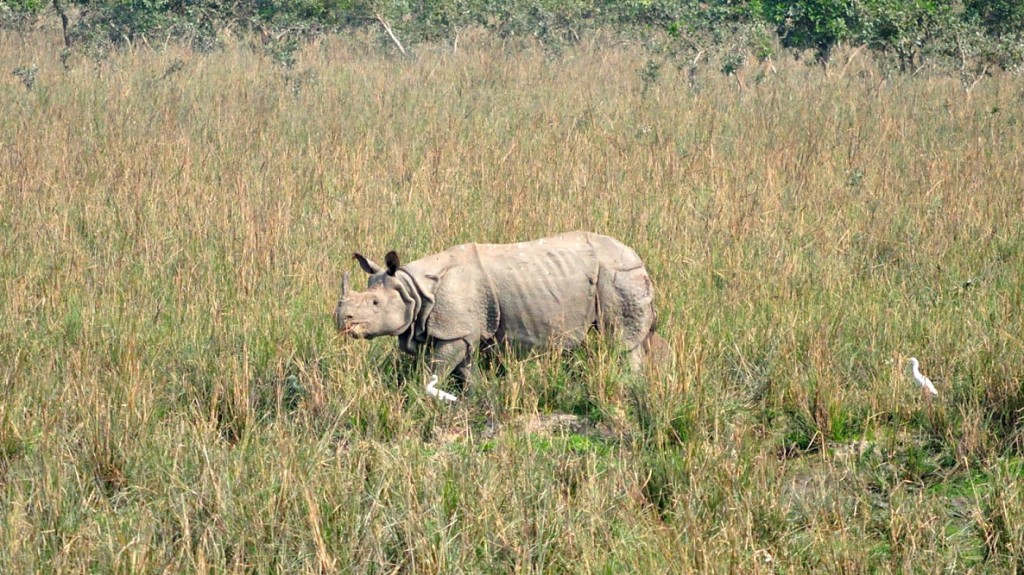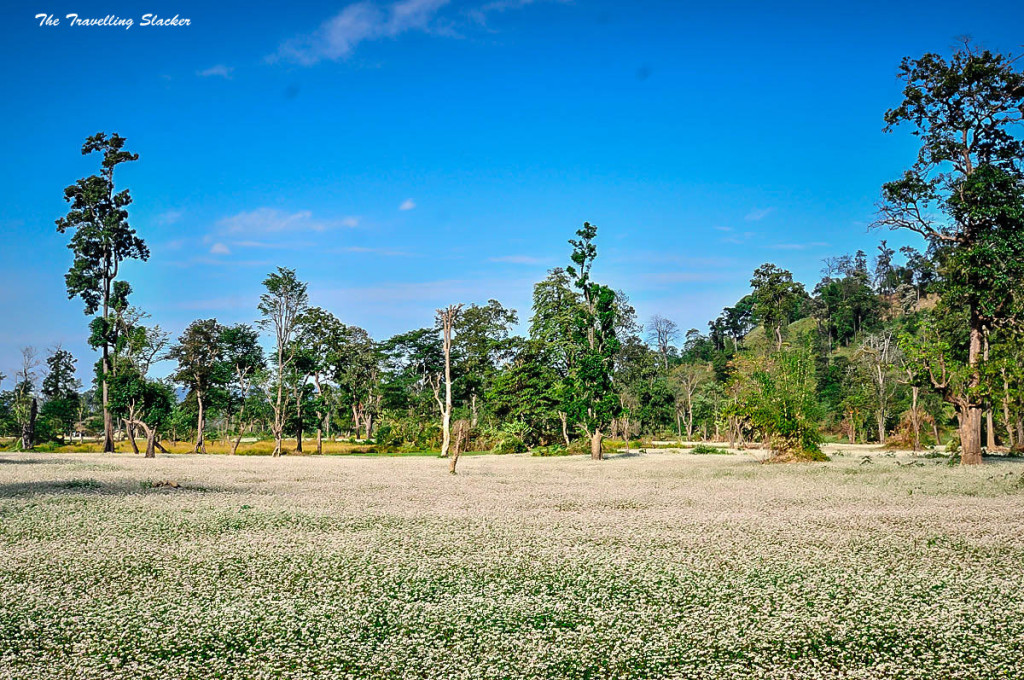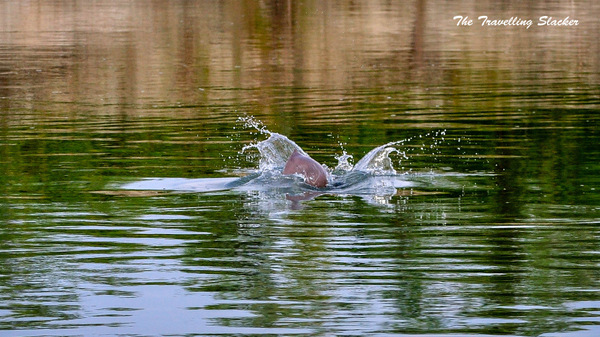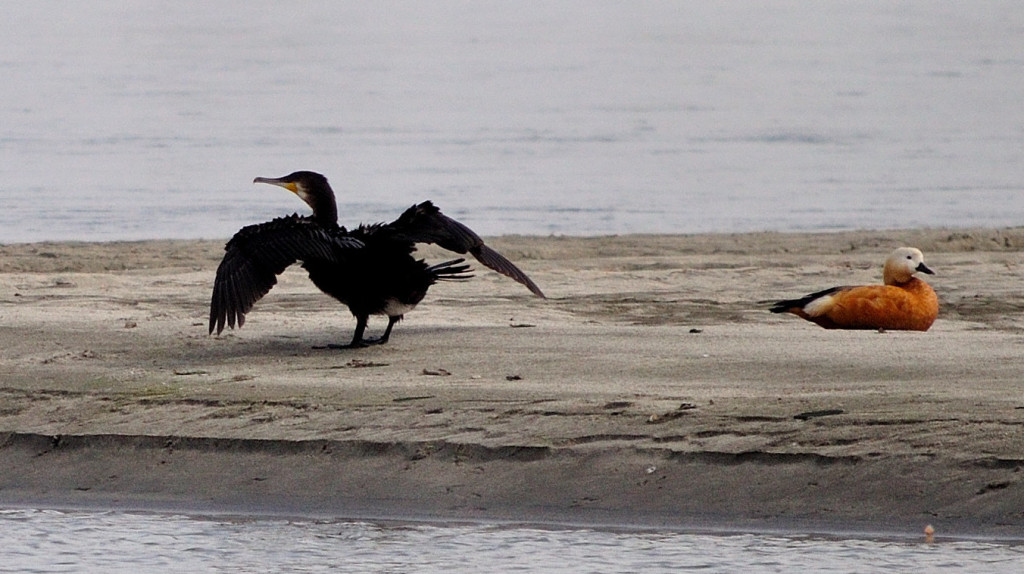This is a list of top places to visit in North East India. This just covers the most famous destinations that first-timers seek to visit. Do note that there are many other options in the remote corners of the region but if it is your first time, you will probably look for something easy and mainstream. Personally, I will prefer something more extreme and I will make a different list for them soon.
Northeast India: Top Experiences
Kaziranga: Spot a One-Horned Rhino
There are only around 2500 greater one-horned rhinoceroses remaining in the wild. Out of them almost 2000 are found in Kaziranga!
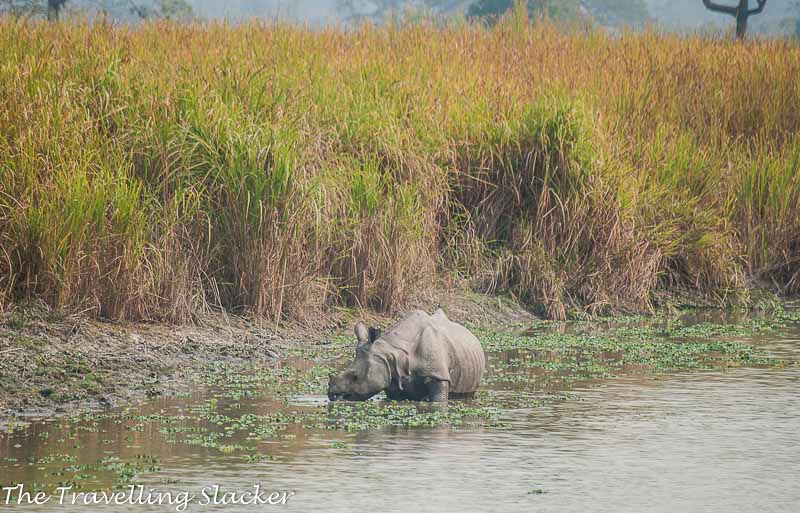
The Indian one-horned rhino is one of the most endangered large mammals in the world and the Kaziranga National Park in Assam is its best-known habitat. A UNESCO World Heritage Site, Kaziranga is a treasure trove of exotic flora and fauna. The gigantic but benevolent rhinos are the biggest crowd-pullers here but there are many other rare animals and birds that can be found here including tigers, elephants, leopards, hoolock gibbons, swamp deer, hog deer, pelicans, greater adjutant storks, white winged wood ducks, and many more.
Kaziranga is one of the most developed tourist areas in the Northeast with scores of resorts, lodges, restaurants and other facilities. Jeep safaris as well as elephant safaris are the primary modes of exploring the national park. Jeeps are more convenient but the elephants can get closer to wild animals. The park gets flooded and closed down during the monsoon season and it is best experienced in the winter, between November to March.
Apart from Kaziranga, Assam is home to several other national parks and wildlife sanctuaries. If you have time, you can combine the Kaziranga visit with many other sanctuaries. For example, the Manas National Park is another UNESCO Site bordering Bhutan that gives you the best of both plains and hills, the Hoollongapar Gibbon Sanctuary protects the hoolock gibbons, the only ape found in India, while the Dibru Saikhowa National Park offers a different experience as you explore the jungles through boats and spot gangetic river dolphins and feral horses.
Try Your Luck at a Casino in Gangtok
Yes, it may come as a shocker to you but casinos can be found in Gangtok where you can try your luck (but make sure that you don’t go overboard. If you have ever fantasized about acting like Bond and trying your luck in style, this is the place for you. Apart from Goa, Sikkim is one state in India where they legally operate casinos and Gangtok, the capital of Sikkim is one of them. Of course, Sikkim has much more to offer and after the Casino, you can move on for some hiking or visit a high-altitude, emerald green lake. Of course, this is not the cup of tea for everyone. Some people may prefer just to enjoy a game of cricket and try their luck from the comfort you their rooms. For example, you may watch the west indies vs bangladesh cricket game on a variety of secure platforms from anywhere.
Majuli: Cultural Melange at the Disappearing River Island
The River Island of Majuli was around 880 sq KMs a 100 years ago. Continuous flooding and erosion has reduced it to 350 Sq KMs now but it is still among the largest of its kind and that is not the only thing about it.
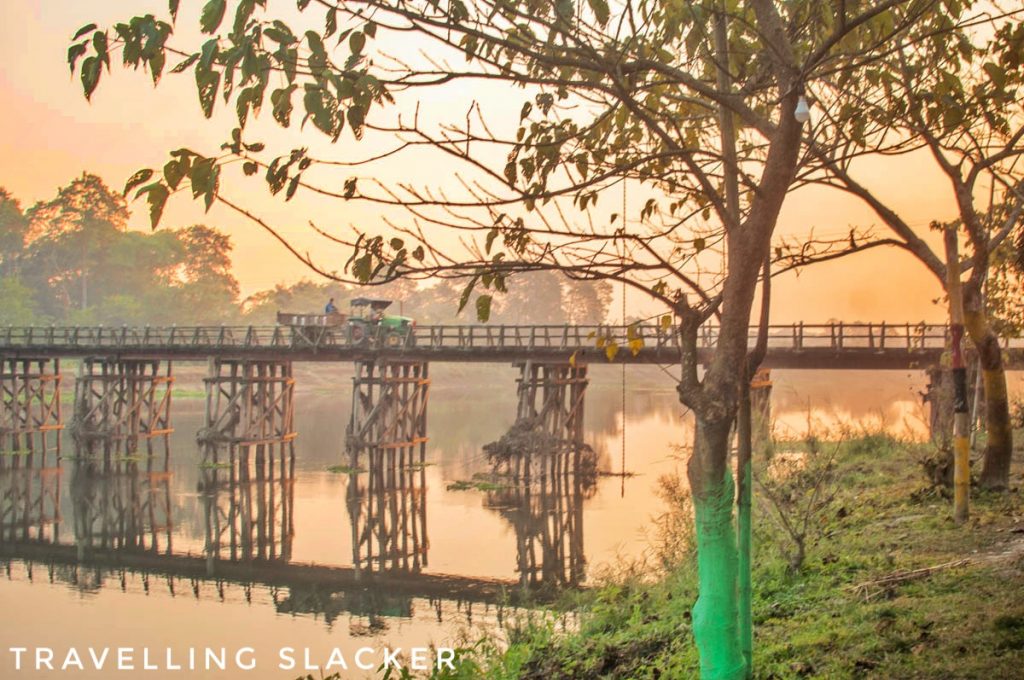
Majuli is a river island on the River Brahmaputra in Assam. It is one of the largest in the world as per the records. However, it used to be even larger but incessant erosion caused by the mighty river has made it shrink gradually and lose two third of its original area. The erosion still continues and the current area stands at around 352 square kms. But still it remains big enough to house several small villages within it and it has been declared as a district on its own, making it the first island district of India and it is also growing fast as a popular tourist destination due to its natural as well as cultural riches.
You don’t have to visit Majuli just because it is mentioned in the record books. There are many other delights offered by this island. In fact, Reaching Majuli itself is an adventure. You need to cross the river on a boat and due to its location, it has seen very limited urbanization. This makes it a secluded, rustic, and peaceful entity far away from other towns and cities in the state. It is also a good spot for nature lovers, especially bird watchers. Many local water birds and some migratory birds are easily visible in the open fields and water bodies all over Majuli.
Majuli is also the cultural centre of Assam, one of the primary centres of the neo-Vaishnavite culture that have been dominating the sociocultural life of most parts of Assam over the last 500 years. There are many “Satras” in Majuli, which are the institutional centres of the aforementioned religious sect. They not only work as religious sites but also as cultural centres that have a huge influence on the social lives of the local people. Classical dance forms, drama, and music have also been developed through these institutions over five centuries.
Unakoti: Face to Face with the Faces
Unakoti literally means one less than a crore (10 million). That was the number of statues originally believed ot have been sculpted in this site!
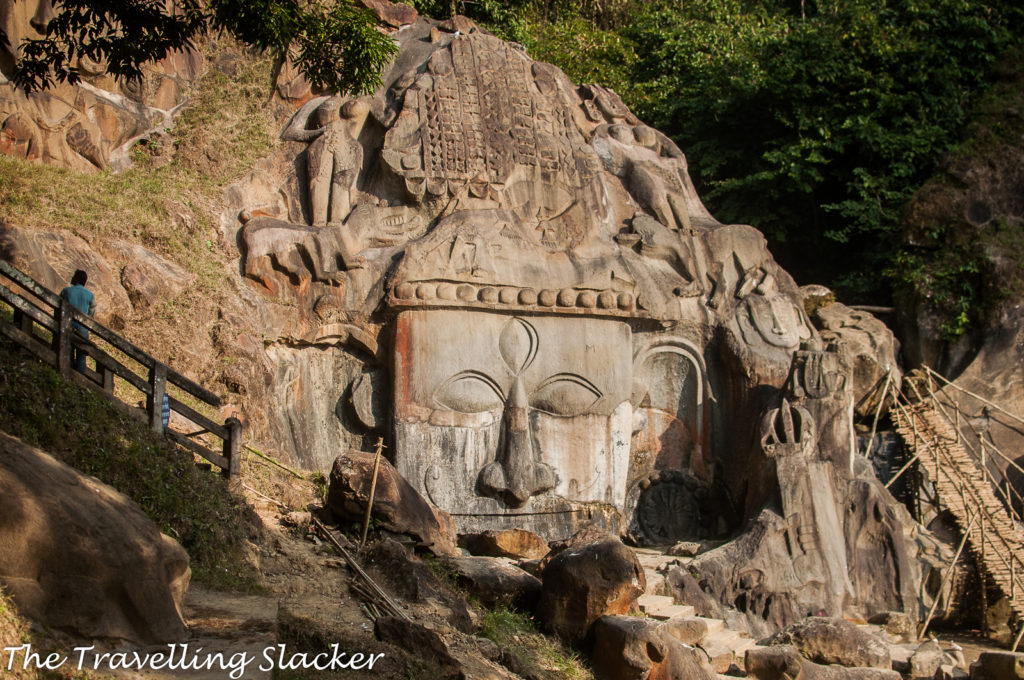
The Northeast is generally not known for archaeological ruins although there are many. If there is one archaeological site that captures immediate attention and has the potential to be a global attraction, it is Unakoti in Tripura. Located in the northern part of Tripura, these are some of the oldest yet best preserved relics from an era that still remains shrouded in mystery.
Although it is not far from the road, the ruins of Unakoti are not easily visible due to hilly terrain and thick vegetation. One needs to walk for almost a kilometre from the main road, and then climb a flight of steep stairs get the first glimpse of those famous faces. To say that the gigantic bas reliefs of Unakoti are “unique” is an understatement. It is hard to find an equally magnificent set of sculptures in the entire region and even in the rest of the country. According to archaeological evidences, these figures were made during 7th to 9th century although no one is clear about the exact origins of the site. Various myths associated with the site has been popularized by Rajmala, the official chronicle of the Manikya dynasty of Tripura. It is a primarily Shivaite site with the faces of related gods and goddesses drawn all over the hills.
Even now you will find scores of them scattered all over the hills of Unakoti. According to one story there was blacksmith who wished to live at the abode of Lord Shiva on the Kailash Mountain. So, Shiva told him that his wish will be fulfilled if he could make a crore idols of Lord Shiva within one night. The blacksmith made a valiant attempt but in the morning, it turned out that he made just one statue less than a crore and this is how the place got its name although no one knows what happened to the blacksmith after that.
Yumthang: The Valley of Flowers
Imagine a vast open valley at an altitude of 3500 meters, covered with wild flowers and 24 varieties of rhododendron, spread till the horizon where they disappear into the snowy Himalayan peaks…
Yumthang Valley is one of the most picturesque, high-altitude valleys in India. The place gained prominence when Dr. Joseph Hooker had mentioned Yumthang and Lachung as the most picturesque places in the entire Sikkim in his “Himalayan Journal” of 1855. The valley is known for the rhododendrons that bloom here and the sulphurous hot springs. The Shingba Rhododendron Sanctuary that is so well known for its variety of rhododendrons is a part of the Yumthang Valley.
In the flowering season between April to June, the entire valley gets covered by a carpet of flowers of different colours. A small tributary of the Teesta River criss-crosses through the valley at the backdrop the mountain ranges and you can see the peaks of Pauhunri and Shundi on the way to Yumthang. There is a wooden bridge with a number of fluttering prayer flags over the rivulet. You have to cross the bridge and hike uphill to reach a hot water spring, which is another attraction here. The waters of this hot spring is said to have medicinal properties.
From Yumthang, you can also travel further to Yumesamdong or Zero Point where you can find snow at all times of the year. The best time to visit Yumthang Valley is between April to June when the entire region gets covered with colourful windflowers. Heavy snowfall takes place in the winter months between December to January. Yumthang Valley can be visited after staying overnight at Lachung and the entire trip is usually done combined with a trip to Lachen and Gurudongmar Lake.
Waterfalls of Meghalaya: Heavenly Cascades
The tallest plunge waterfall in India? A waterfall with a perennial rainbow over it? Waterfalls with living root bridges? What about a bluish green fall with three different steps?
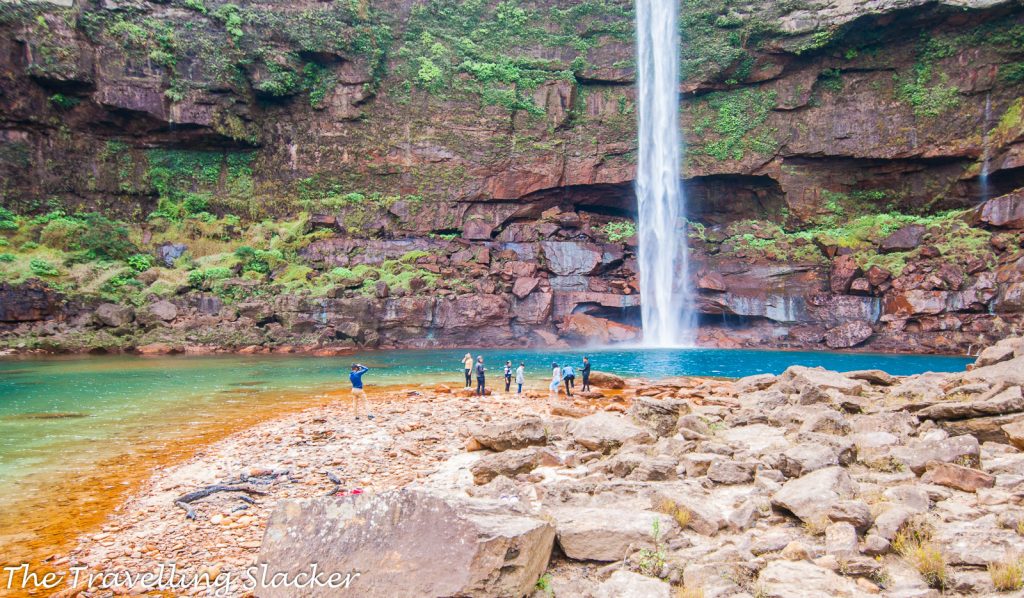
Yes, Meghalaya offers all of that, and much more for waterfall lovers. You may ask what is the big deal with waterfalls and that they can be found all over India… but those who have been there will agree that Meghalaya has some of the most exotic waterfalls in India and that too in thick concentration.
Interestingly, only a few of them were known and accessible to tourists till the last decade. However, with the tourism boom of late, newer waterfalls keep getting discovered, and turned into tourist hotspots overnight!
If you are familiar with Meghalaya, you will know that the state is broadly divided into three regions, the Khasi Hills, Jaintia Hills, and Garo Hills. The best known falls are those of Khasi Hills including the ones around Shillong such as Elephanta Falls & Beadon Bishop, and around Cherrapunjee such as Nohkalikai, Rainbow Falls, Wei Sawdong, Dainthlen, Seven Sister’s Fall etc.
The ones in Jaintia Hills were not famous earlier but becoming gradually popular as their surreal images are gaining traction all over social media. Such falls include Krang Suri, Phe Phe Falls, Suwa Ludong, Tyrshi, Moopun, Rynji etc.
Even more remote is the Garo Hills. This region is the remotest and yet to fully realize its tourism potential and naturally, the falls like Pelga Falls, Imil-Chang-Dare, Rong’bang Dare etc remain untouched. Naturally, you can’t see each and everyone of them in one go. However, a knowledgeable guide can help you cover the most iconic ones in a matter of a few days days.
Dzukou Valley: Trek to the Garden of Eden
The Dzukou Lily blooms in the hills of Dzukou every summer. It is an endemic species i.e. it can be found only here and nowhere else!
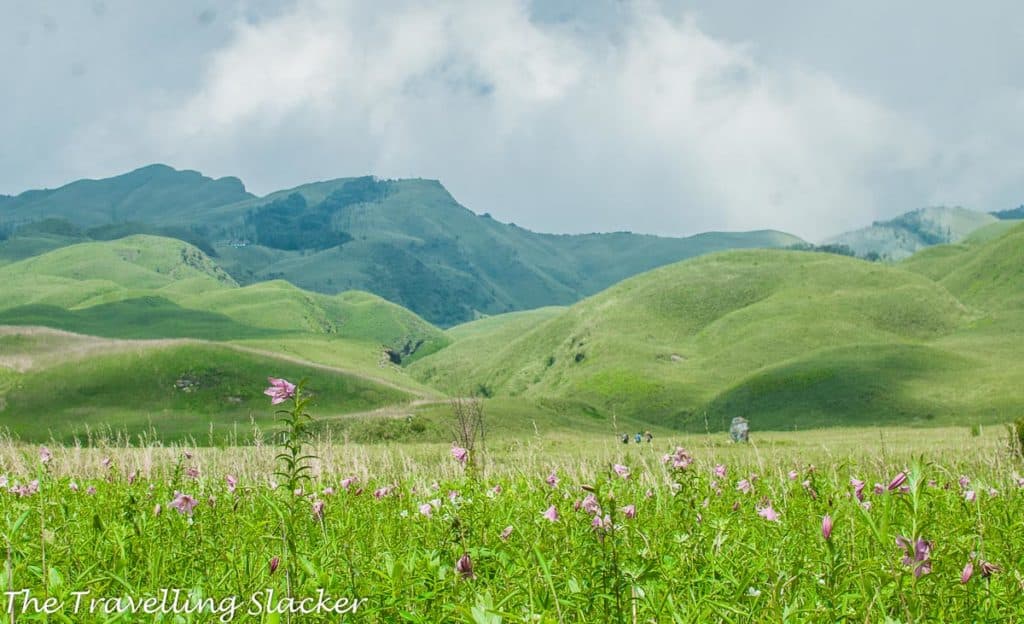
It is hard to express Dzukou Valley in words. You might have done other treks, you might have seen high altitude meadows and rolling hills, but most probably you have not seen anything like Dzukou. One way to explain it is probably describe it as cluster of many miniature plateaus in one place. In any case, must visit the place to know what it exactly is.
Dzukou Valley trek is the easiest yet one of the finest and most unique treks in the entire Northeast India. The trekking point is barely 20 KMs from the capital city of Kohima and so it also remains one of the most accessible ones. There are multiple routes to the valley from the roadside and the valley is also connected to Manipur on the other side. A short steep but short hike takes you to the 2500 meter high valley.
Dzukou remains accessible throughout the year but in the summers the lush green valley gets covered by multicoloured wild-blossoms. One of the rarest endemic flowers here is called the “Dzukou Lily” that blooms only for a couple of weeks. The best way to experience the valley is to spend at least one night at the top and keep enough time for exploring and photographing the valley. There is a tourist hut maintained by the officials at the top and food is also provided by them.
Tawang: A date with Buddha at the Frontier
Tawang borders Tibet and has always been a part of Tibetan Buddhist influence. In fact, the 6th Dalai Lama (1683-1706) was born here!
Tawang, bordering Tibet on the north-western corner of Arunachal Pradesh, is a major centre of Tibetan Buddhism and it has played an important role in their history. Even now, it houses one of the largest monasteries in the world and there is much more to see here beyond that, which makes it among the top places to visit in north east India.
The 400 year old Tawang Monastery atop the hill dominates the landscape of Tawang and it is the largest monastery in India and second largest in the world after the one in Lhasa, which itself makes it worth a visit. You can go beyond Tawang to visit attractions such as Bum La, an old trading route connecting to Tibet, Sangetsar Tso, a beautiful high altitude lake that is also known as Madhuri Lake after the Bollywood actress who once shot a film here, and several war memorials and shrines from the 1962 Indo-China war.
The route leading to Tawang also has many other attractions. It passes through the likes of Tezpur, a historical town in Assam, as well as a picturesque towns in Arunachal such as Bhalukpong and Bomdila. You also pass through Dirang, a serene Buddhist town, which is the gateway to Sangti Valley, a secluded paradise covered with pristine forests and fruit orchards. More hardcore travellers can also consider some treks around the Gorichen Mountain.
Loktak Lake: World’s Only Floating National Park
Have you heard of the only floating national park in India? Do you know that this is near Moirang, the point till where the INA led by Netaji Subhash Bose managed to reach in 1945?
The Loktak Lake in Manipur is the largest freshwater lake in the Northeast India. It has a distinctive landscape because of the floating phumdis (mass of grass, soil, and organic matters). A boat ride through the lake can take you to the Keibul Lamjao National Park, which is the last remaining habitat of the endangered sangai deer (Manipur brow-antlered deer), one of three subspecies of the Eld’s Deer.
This lake plays an important role in the life, culture, and economy of Manipur. It is a major source of irrigation as well as drinking water supply. It is also a source of livelihood for the local fisherman who live on the banks of the lake as well as on phumdis. From fishes to lotus stems, a lot of things collected from here makes way to the markets of the towns.
Loktak is located near the town of Moirang, which is not far from the capital Imphal. Moirang itself is a historical town that saw heavy fighting during the Japanese Invasion towards the end stages of the World War II. The Indian National Army under Subhash Bose reached here from the east. So, there is a INA Museum dedicated to their memory in Moirang that stores many rare historical documents and can be visited as a quick detour after visiting Loktak.
Living Root Bridges: A Bioengineering Marvel from Meghalaya
What is the most unique bridge you have ever crossed? What about a bridge that is living and growing?
Certain spots in the Khasi Hills of Meghalaya are believed to be among the rainiest places in the world as per the Guinness Book of World Records. However, that is only one of the reasons to visit this area. The fertile slopes of these hills have many gems hidden inside them.
The Living Root Bridges are one of the most unique examples of sustainable bio-engineering that draws people from all over the world. These bridges are built over small rivers and streams by guiding the roots of certain trees. As the tree grows over the years, the bridge also grows and becomes consolidated. The Khasis of Meghalaya have been doing this for several centuries. Just imagine a bridge built without cutting a tree and without using any modern machinery or damaging the ecology. Modern civilization can learn a lot from this.
There are many such bridges in Meghalaya but the best known one is the double-decker root bridge in Nongriat. It takes a short but steep trek from Cherrapunji to reach this secluded village, surrounded by dense forest, bluish green rivers, and roaring waterfalls. Apart from the root bridge, you can also hike to the surreal rainbow fall and swim in the natural blue lagoon here. Another famous root bridge is located in Riwai, near Mawlynnong, which is otherwise famous as the “cleanest village in Asia”.
Dawki & Shnogpdeng: A Boat Ride over the Crystal River
“What about a boat ride along a pristine, bluish green river? What if it is so pristine that you can see the pebbles at the bottom of the riverbed?”
Dawki and nearby village of Shnogpdeng used to be one of the hidden gems of Meghalaya that became suddenly famous a few years ago. Dawki is situated on the south-eastern border of Meghalaya, around 82 km south of Shillong. Its proximity to the Bangladesh border adds another attraction to its credit. The small border town of Dawki in the West Jaintia Hills has the famous river Umngot which is a major tourist destination in Meghalaya.
A boat ride through the river and one will actually be able to see the bottom of the river even when it is around 15 -20 feet deep. The entire boat ride can take up to an hour or so with around 20 mins on the boat in the middle of the river and rest on a small island, where one will find plenty of smooth and round boulders and rocks. This makes a perfect setting for those wanderlust pictures you need for a trip.
Towards the shallow end of the river, travellers can even get into the river for a quick swim since the current is not really strong; a walk over the cable suspension bridge gives one a beautiful panoramic view of the hills and the Bangladesh plains. Dawki is also easily reachable from Shillong and there are many stay options at Dawki, as well as the nearby village of Shnopdeng.
Ziro: Not just a Music Festival
The Ziro Festival of Music has single-handedly brought Ziro to the forefront of tourism in Northeast India. Wildly successful and popular, this event takes place every September in the lush, open valleys of Ziro as scores of bands and musicians from all over India and abroad gather and take part in this musical extravaganza. However, it is not only limited to that. The Ziro Valley is a great example of co-existence of humans and nature, something that has been perfected by the Apatanis over centuries. The agricultural skills and ecological knowledge of the Apatanis is unparalleled and is visible in their management and conservation of limited natural resources, perfected over centuries of experimentation. Especially noticeable is their wet-rice cultivation on the plains where they also rear fishes on the same fields. They supplement the same with millets on the hilly slopes. Most of them also follow Donyi-Polo religion, which is completely unique and has no relation to major organized religions of the world. In short, it is a treasure trove for cultural and ecotourism.
Rih Dil: To the Heart Lake in Myanmar
“Rih Dil is the largest lake in Mizoram, but is situated in Myanmar!”
Sounds confusing? Actually, the lake is located on the border of Mizoram and Myanmar. You have to momentarily cross the international border to reach the lake. So, it is not a mere lake visit but it also adds Myanmar to your list of bragging points. However, it is also deeply linked to Mizo culture and folklore and so it is not considered a foreign location by them.
The Rih Dil is one of the most prominent lakes in the region. “Dil” means Lake in Mizo language while it means heart in Hindi and serendipitously, the lake indeed is heart-shaped! According to the local legends, the lake is believed to be the passage that the spirits of the dead crossed in order to reach the other world, the final abode of the spirits. There are scores of other stories woven around the origin of this lake that have enriched Mizo literature and poetry over generations.
Rih lake is just a few KMs from Tiau which is the boundary river between Mizoram and Chin State (Myanmar), and is considered within area of Rihkhawdar village in Myanmar. Reaching the village itself is an adventure as you pass through pristine terrains seldom frequented by tourists and listen to mythical stories. The nearest big town from the lake is Champai, which is around 22 KMs away. Champai itself is around 185 KMs from capital Aizawl.
Mon: The Land of the Tatooed Headhunters
“What qualifies as unique and exotic in your book? What about a cupboard full of skulls?”
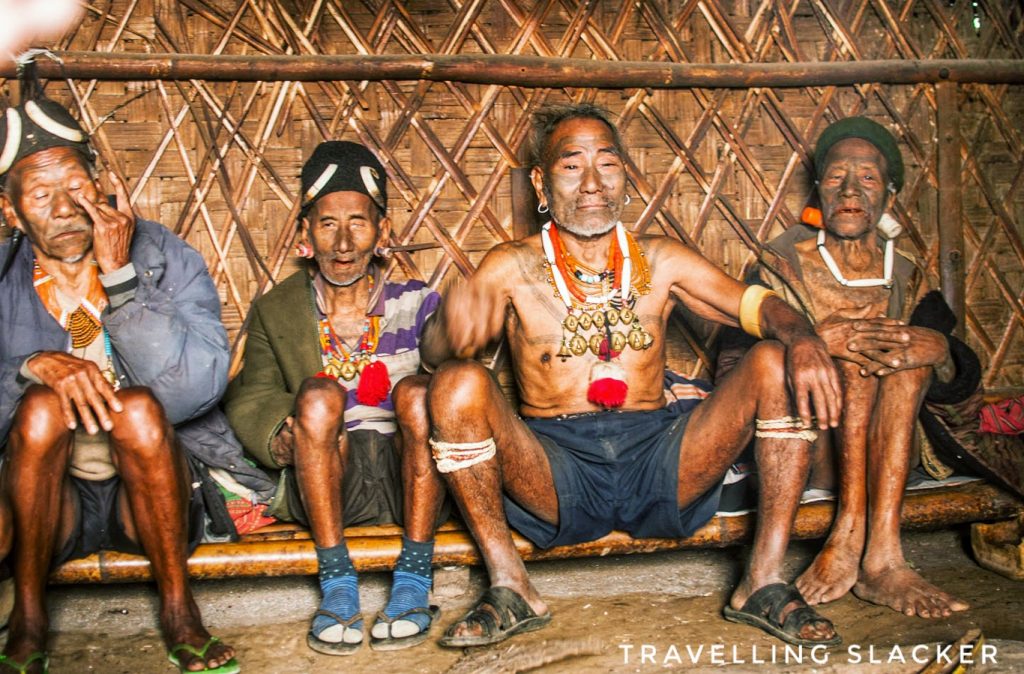
Well, no need to get scared. The Konyaks of Nagaland were fierce warriors and they did collect the severed heads of their enemies in the past. It is not much different from the rest of us, everyone had to fight for survival in the olden days. It is just that they preserved those skulls as trophies, and became famous as headhunters. Konyaks have very strong and athletic build and they can be distinguished by their tatooes and piercings.
The Mon District of Nagaland is the primary habitat of the Konyaks and they were the last ones in the region to adapt western practices. It is one of the remotest regions in the country and their rugged lifestyle is believed to have made them strong and given them longevity. This is why their lifestyle and culture are nowadays attracting a lot of people from all over the world.
Reaching Mon is easier from Sivasagar district of Assam than from Kohima. One of the best places to stay in Mon is the village of Longwa, which is the largest village in the area located on the border of Myanmar. In fact, one-half of the village lies on the Indian side while the other half is in Myanmar. Additionally, you can also explore the village of Hongfoi, which has the maximum number of old surviving headhunters.
Brahmaputra River Cruise: Along the Lohit
The Brahmaputra originates in Tibet and meets the oceans in Bangladesh. A cruise through the river is also a cruise through a civilization that blossoms on the banks of this great river.
Brahmaputra is one of the great rivers of India and is also one of the longest. This river is so deep and powerful that it remains navigable throughout the year, including the dry winter. Still, the river and its banks remained rarely explored until recently. However, the river cruise facility along the Brahmaputra was introduced a few years ago and it has become popular pretty quickly.
A river cruise from Guwahati to Dibrugarh is just like an ocean cruise, where you get your own cabin in a ship, and it goes on for several days. It makes stop at various points so that you explore some of the best destinations in Assam, including Kaziranga National Park, famous for one-horned rhinos, Majuli, the largest river island in the world and cultural capital of Assam, Sivasagar, a heritage city and medieval capital of India, and various lush green tea gardens, since Assam is also the largest tea producer in the world.
The good thing about the cruise is that it not only offers you the thrill of sailing but also takes you to most of the major attractions of the state in one go. This trip lasts around a week and is ideally done in the dry season of November to March, when the river is calm and the banks are not flooded.
The Northeast Festival Trail: Cultural Conquests
The tourism festivals in the Northeast are not mere fun events but cultural kaleidoscopes that can be easily clubbed with other explorations.
When the Hornbill Festival was started in Nagaland a few years ago, the tourism scene in the region was still at a nascent state. This festival showcased the best of Nagaland, and by extension, showcased the tourism potential of the whole region. The success of this festival has given rise to scores of other tourism festivals targeted at tourists to promote a particular state or an area. From cultural events to rock concerts, and from traditional sports to abundant rice beer, there is enough to keep everyone hooked in such festivals.
If someone is new to the region, this is a great way to kick-start a northeast tour. Apart from Hornbill, the other popular tourism events include the Cherry Blossom Festival in Shillong (to celebrate the onset of cherry blossoms), Shirui Lily Festival in Ukhrul (to celebrate the blooming of Shirui Lilies), Dambuk Orange Festival in Arunachal, Ziro Music Festival in Arunachal, Tawang Festival in Arunachal, Sangai Festival in Manipur, Anthurium Festival in Mizoram, Pangasu Pass Winter Festival in Arunachal etc, Dwijing Fetsival in Bodoland, Assam. Apart from these, you also have scores of traditional festivals all over the region such as Bihu in Assam, Mopin Festival in Arunachal, Wangala Festival in Garo Hills etc.
A good idea to experience them is the plan ahead and club the visits with other destinations nearby. Most of the tourism festivals take places during the autumn and winter months (Except Shirui Festival), when the weather is dry and pleasant. On the other hand most of the traditional festivals are likely to take place in the spring month of April. So, if you time it well, you can experience multiple of them during the same trip, one after one.
Trekking in Sikkim: Under the Shadow of Kanchenjunga
“At 8586 meters, Kanchenjunga is the third highest peak in the world and the mountain ranges spread all around the peak makes Sikkim one the best trekking destinations.”
While most NE states have hills, trekking opportunities have not been fully explored in some of these areas due to remoteness and lack of infrastructure. However, this is what sets Sikkim apart. It is home to the third-highest peak in the world and it borders Nepal. This is why this has been popular among trekkers and mountaineers for a long time. Even if you are not a hardcore climber, you can opt for many short as well as long treks in Sikkim and there are many options for both beginners and veteran trekkers.
Probably one of the most gorgeous multi-day Himalayan treks, the Goechela Trek has its base camp at Yuksom, west Sikkim. Goechela Trek lasts 10-11 days and you get grand views of some of the tallest Himalayan peaks. You can see as many as 14 summits and you get as close as possible to Kanchenjunga (8,586 m), the third-highest peak in the world. The highest altitude you gain in the trek is 15100 ft and the adrenaline rush that you get from the steep trails of the trek is unparalleled. The area surrounding the peak, known as Kanchenjunga National Park, covering parts of West and North Sikkim, is so rich in biodiversity as well as cultural and historical treasures that the are has been designated as a UNESCO World Heritage Site in the mixed heritage category.
If you need something shorter and easier, you can try the Varsey Rhododendron Sanctuary Trek. You must do it in the spring months of March-April when bright red rhododendron blossoms turn the hills sanguine. Situated at the south-west part of West Sikkim, Varsey Rhododendron Sanctuary spreads over 104 sq km across the Singalila range. Apart from these, there are scores of other treks in Sikkim such as the Dzongri Trek, Green Lake Trek, Uttarey Singalila Trek, Kanchenjunga Base Camp Trek etc.

